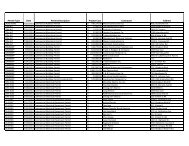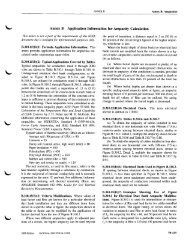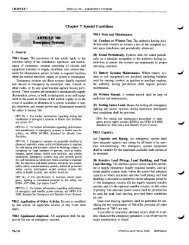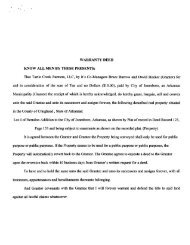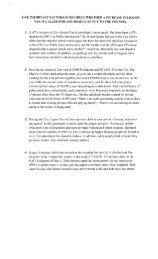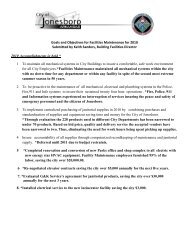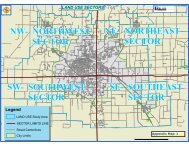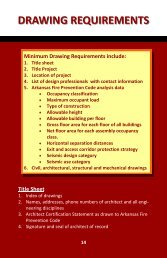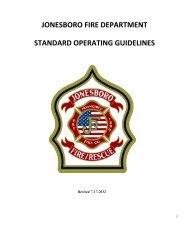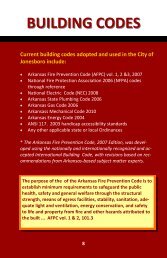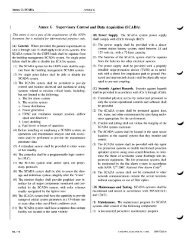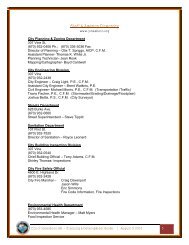Chapter 3 Wiring Methods and Materials
Chapter 3 Wiring Methods and Materials
Chapter 3 Wiring Methods and Materials
Create successful ePaper yourself
Turn your PDF publications into a flip-book with our unique Google optimized e-Paper software.
ARTICLE 320 -<br />
ARMORED CABLE: lYPE AC<br />
320.10<br />
<strong>and</strong> legibly marked with the manufacturer's name or trademark.<br />
IV. Pull <strong>and</strong> Junction Boxes for Use on Systems over<br />
600 Volts, Nominal<br />
314.70 General. Where pull <strong>and</strong> junction boxes are used<br />
on systems over 600 volts, the installation shall comply<br />
with the provisions of Part IV <strong>and</strong> also with the following<br />
general provisions of this article:<br />
(1) Part I, 314.2, 314.3, <strong>and</strong> 314.4<br />
(2) Part II, 314.15; 314.17; 314.20; 314.23(A), (B), or (G);<br />
314.28(B); <strong>and</strong> 314.29<br />
(3) Part III, 314.40(A) <strong>and</strong> (C) <strong>and</strong> 314.41<br />
314.71 Size of Pull <strong>and</strong> Junction Boxes. Pull <strong>and</strong> junction<br />
boxes shall provide adequate space <strong>and</strong> dimensions for the<br />
installation of conductors, <strong>and</strong> they shall comply with the<br />
specific requirements of this section.<br />
Exception: Terminal housings supplied with motors shall<br />
comply with the provisions of 430.12.<br />
(A) For Straight Pulls. The length of the box shall not be<br />
less than 48 times the outside diameter, over sheath, of the<br />
largest shielded or lead-covered conductor or cable entering<br />
the box. The length shall not be less than 32 times the outside<br />
diameter of the largest nonshielded conductor or cable.<br />
(B) For Angle or U Pulls.<br />
(1) Distance to Opposite Wall. The distance between each<br />
cable or conductor entry inside the box <strong>and</strong> the opposite<br />
wall of the box shall not be less than 36 times the outside<br />
diameter, over sheath, of the largest cable or conductor. This<br />
distance shall be incmased for additional entries by the amount<br />
of the sum of the outside diameters, over sheath, of all other<br />
cables or conductor entries through the same wall of the box.<br />
Exception No.1: Where a conductor or cable entry is in<br />
the wall of a box opposite a removable cover, the distance<br />
from that wall to the cover shall be permitted to be not less<br />
than the bending radius for the conductors as provided in<br />
300.34.<br />
Exception No.2: Where cables are nonshielded <strong>and</strong> not<br />
lead covered, the distance of 36 times the outside diameter<br />
shall be permitted to be reduced to 24 times the outside<br />
diameter.<br />
(2) Distance Between Entry <strong>and</strong> Exit. The distance between<br />
a cable or conductor entry <strong>and</strong> its exit from the box<br />
shall not be less than 36 times the outside diameter, over<br />
sheath, of that cable or conductor.<br />
Exception: Where cables are nonshielded <strong>and</strong> not lead<br />
covered, the distance of36 times the outside diameter shall<br />
be permitted to be reduced to 24 times the outside diameter.<br />
(C) Removable Sides. One or more sides of any pull box<br />
shall be removable.<br />
314.72 Construction <strong>and</strong> Installation Requirements.<br />
(A) Corrosion Protection. Boxes shall be made of material<br />
inherently resistant to corrosion or shall be suitably<br />
protected, both internally <strong>and</strong> externally, by enameling, galvanizing,<br />
plating, or other means.<br />
(B) Passing Through Partitions. Suitable bushings,<br />
shields, or fittings having smooth, rounded edges shall be<br />
provided where conductors or cables pass through partitions<br />
<strong>and</strong> at other locations where necessary.<br />
(C) Complete Enclosure. Boxes shall provide a complete<br />
enclosure for the contained conductors or cables.<br />
(D) <strong>Wiring</strong> Is Accessible. Boxes shall be installed so that<br />
the wiring is accessible without removing any part of the<br />
building. Working space shall be provided in accordance<br />
with 110.34.<br />
(E) Suitable Covers. Boxes shall be closed by suitable<br />
covers securely fastened in place. Underground box covers<br />
that weigh over 45 kg (l00 Ib) shall be considered meeting<br />
this requirement. Covers for boxes shall be permanently<br />
marked "DANGER - HIGH VOLTAGE - KEEP OUT."<br />
The marking shall be on the outside of the box cover <strong>and</strong><br />
shall be readily visible. Letters shall be block type <strong>and</strong> at<br />
least 13 mm (V2 in.) in height.<br />
(F) Suitable for Expected H<strong>and</strong>ling. Boxes <strong>and</strong> their<br />
covers shall be capable of withst<strong>and</strong>ing the h<strong>and</strong>ling to<br />
which they are likely to be subjected.<br />
I. General<br />
320.1 Scope. This article covers the use, installation, <strong>and</strong><br />
construction specifications for armored cable, Type AC.<br />
320.2 Definition.<br />
Armored Cable, Type AC. A fabricated assembly of insulated<br />
conductors in a flexible metallic enclosure. See<br />
320.100.<br />
II. Installation<br />
320.10 Uses Permitted. Type AC cable shall be permitted<br />
as follows:<br />
2008 Edition NATlO''lAL ELECTRICAL CODE<br />
70-175



